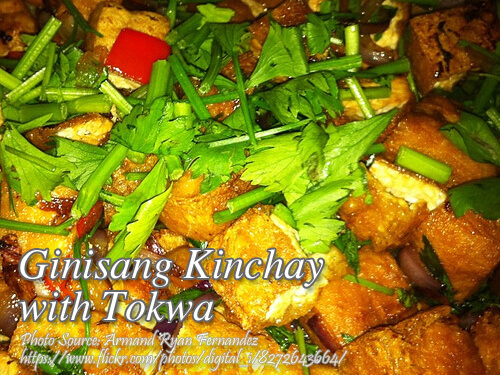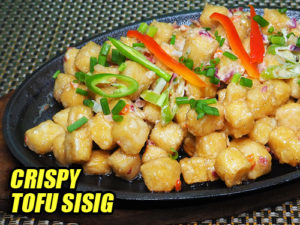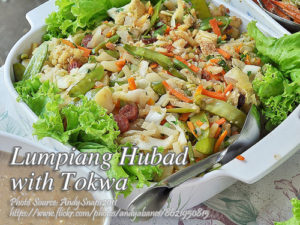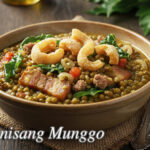If you are looking for a simple vegetable recipe containing tokwa or tofu, then I think this ginisang kinchay with tokwa dish is a good choice. Just don’t be confused when buying kinchay because it resembles to wansoy. Although they both look alike, the taste and smell is different to each other.
Kinchay is Chinese celery and it is small compared to the Western celery we see most of the time in supermarkets. But they almost taste the same its just Chinese celery has a stronger taste than the Western celery. Wansoy on the other hand is coriander or cilantro which some describe it with a citrus like taste and some say it taste like soap. Anyway just use kinchay to be sure.
Ginisang Kinchay with Tokwa: The Simple, Flavorful Dish of My Childhood
As a child, my family and I always seemed to cook the most basic yet tasteful dishes. Among these dishes, I still fondly remember my mother’s regular cooking of this very simple but delicious stir-fry of tofu with Chinese celery. Actually, the tofu was fried to a golden-brown crust, making every bite lively and crispy with one layer of texture. It did not become a staple dish because it could be affordable but rather because it was rich with comforting flavors. And it felt comforting for nostalgias sake.
Tofu and vegetable stir-fry must be on your list because, if you are in a mood for such a meal with minimal preparation but packing loads of flavor and nutrition, it is sure to come in handy. It is the kind of food that will allow the subtle but impactful taste of kinchay or Chinese celery to better come forth while getting to savor the crispy bites of tofu.
Understanding Kinchay: The Star of the Dish
Before we dive into the dish, let me say a little about kinchay. Before I started cooking, I’d more often than not mistake it for cilantro or wansoy – Filipino for Chinese parsley, which resembles the other two pretty closely, but in so far as the flavor profile is concerned, not at all. Chinese celery has a much bolder, stronger taste than the softer, citrusy note of the cilantro. My uncle always claims, “If it smells sharp and has smaller leaves, you’ve got kinchay.” It is a very delicate pointer, but when it comes to buying for ingredients, it becomes a huge difference. Western celery tends to be bigger and milder, but this Asian variety is small but packs in the flavor.
In various Chinese and Filipino homes, kinchay is used with a stir-fry or even soups, and is famous for cutting through the more decadent flavors of pork or tofu. It adds a freshness to the dish that is quite indispensable, especially to this recipe. You can also learn through this dish how to use kinchay if you are a novice cook.
The Perfect Tofu: Crunchy Outside, Soft Inside
Tofu has always been kept in the kitchen as a versatile ingredient my family always has, well, just about anywhere. My sister, who spent sometime in a small town in the Philippines, told me how she’d be frying it slightly before adding it to her dish. “It gives a satisfying texture,” she would say-and boy, was she right. What makes the dish tasty is that the different textures of the crunchy exterior and the soft, pillowy interior of the tofu come together. The sauce really penetrates and complements the flavor every time it hits your tongue because the fried tofu is cooked just right.
In this dish, the tofu adds a subtle earthy kind of taste to balance out the pungent flavors of the kinchay, making it a great source of protein if you want a meatless meal. Of course, if you’re feeling a bit more adventurous and craving something a little more substantial, go ahead and substitute the tofu with pork liver or pork belly — both versions work beautifully in this recipe. Can’t you envision tender pieces of pork simmering with the vegetables, absorbing every savory flavor?
The History Behind the Simplicity
This simple stir-fry speaks volumes about the resourcefulness of Filipino cuisine. It’s something you’ll find cooking in most homes and, more particularly, on days when you feel like cooking something healthy but not fussing much. My grandmother would tell us that dishes such as these were born of necessity, made with affordable ingredients and the easily accessible, such as tofu and kinchay, to make something worthwhile. Generally, pork was a luxury good, and families tended to supplement the meal with additional vegetables and plant-based proteins like tofu to make it stretch.
Indeed, the Chinese influence together with Pinoy creativity are what make so many of our most-loved dishes. Stir-fries, or gisa, are quick, easy, and perfect for busy households. The addition of kinchay and tofu gives the dish a touch of Chinese flavor, whereas the method of sautéing-that deeply rooted in Filipino cooking-gives it a homestyle, comforting feel.
Tips for Beginners
If you’re just starting to cook, do not be intimidated by this recipe. This is what I learned from cooking: even the simplest could have the most complex flavors if you pay attention to little details. Fry the tofu just right so that it has a lovely crunch. Let the pork cook until tender but not overcooked. And never skimp on the kinchay because that’s where the magic lies.
This dish is such a great way to add some extra veggies for the adventure-seekers. Kangkong is another really good leafy green with nice texture and color; it is actually one of those favorite vegetables in Filipino houses- versatile in many soups and stir-fries.
A Recipe That Unites
Every time I make this dish, it reminds me of spending weekends at my grandmother’s house; it is then that the aroma of the sautéing garlic, onions, and tomatoes would fill the air. There is something so comforting about a humble but flavorfully digestible dish-things that can be done for love even on busy days.
So whether you’re feeding one or feeding a family, this stir-fry is sure to please. Serve over steaming white rice for a meal that feels at once familiar and fresh, perfect for any day of the week.
How to Cook Ginisang Kinchay with Tokwa
Ingredients
- 2 cups kinchay cut about 1 inch long
- 1 cup tokwa cut into 1/2" cubes
- 1/4 kilo pork belly cut into small cubes
- 2 cups kangkong cut into 1 inch long (tender stalks)
- 2 Tbsp. tausi
- 1 medium size onions sliced
- 2 pcs tomatoes sliced
- 3 cloves garlic crushed
- 1 tsp. MSG optional
- 2 Tbsp. cooking oil
- 1 cup water
- 1 Tbsp. cornstarch dissolved in 1 Tbsp. water
Instructions
How to cook Ginisang Kinchay with Tokwa:
- Fry tokwa until skin is firm and a little brown. Set aside.
- Saute garlic until brown. Add onions and tomatoes. Saute for 2 minutes, then add pork.
- Stir the add 1/4 cup water. Cover and simmer until pork is tender. Add more water if necessary to prevent the pork from burning.
- Add the kinchay, kankong and tausi. Cook and stir for 2 minutes, add water. When it boils drop in fried tokwa.
- Cook for 3 minutes more then pour in dissolved cornstarch. Stir until sauce thickens. Serve hot.
- You can also substitute the pork belly with pork liver then slice into strips.
Notes
Cooking Tips:
Fry the Tofu Till it Turns Golden Brown
This is how to achieve that crunchy exterior with tofu still soft on the inside. One must fry tofu over medium heat until it is golden brown, and at the same time, there has to be enough oil in the pan for the tofu not to get stuck there but not so much that it turns greasy. You can let it sit out on paper towels after frying to drain off extra oil so it stays crispy.Simmer the Pork for Maximum Flavor
Let the pork cook long enough to boil down and absorb all the flavors of garlic, onions, and tomatoes. Then add just a little water as it cooks to avoid the meat from drying out, but not too much so that it would dilute the sauce. From there, it will tenderize the pork, making it soft, juicy, and adequately seasoned by the time kinchay is added into the fray.Add Kinchay and Kangkong Last
These greens must be added to the dish towards the end of its preparation time to keep the bright, fresh flavor and texture in place. Overcooking tends to rob the greens of their vibrancy in color and crunch. Just stir them into the dish until they wilt only slightly, as this will ensure that the greens retain most of their nutrient value while also enhancing the taste of the entire dish.






I would like to try making this recipe, what is Tausi?
Hi Angela, Tausi is Chinese salted black beans which you can buy in small cans or pouch.